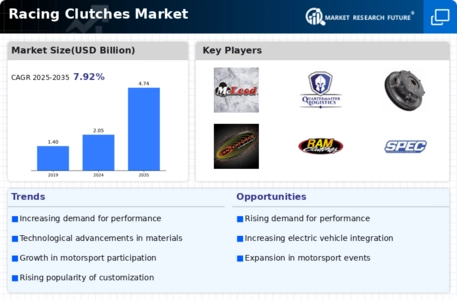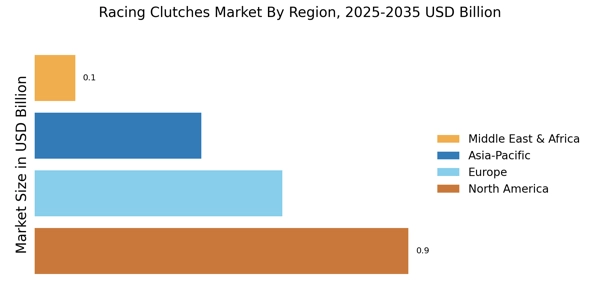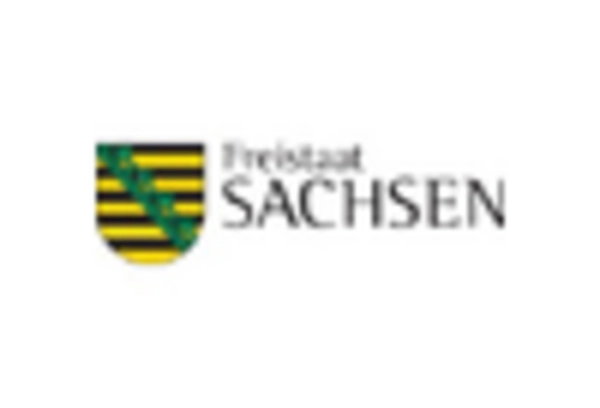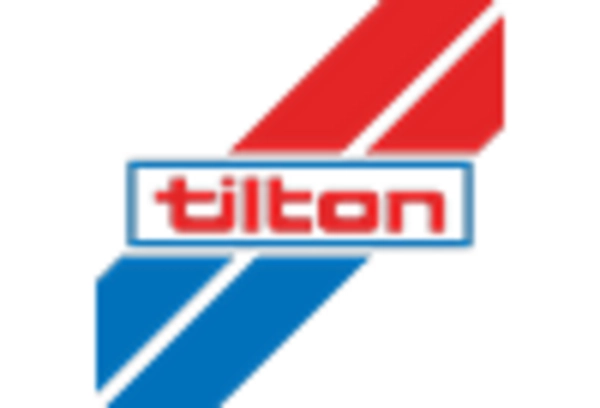Rising Popularity of Motorsports
The Racing Clutches Market is significantly influenced by the rising popularity of motorsports across various regions. Events such as Formula 1, NASCAR, and local racing leagues have garnered substantial viewership and participation, leading to an increased interest in racing vehicles. This trend has resulted in a projected growth rate of around 10% in the racing vehicle segment, which directly correlates with the demand for specialized racing clutches. As more individuals engage in motorsports, the need for high-performance clutches that can handle extreme conditions becomes critical. This growing enthusiasm for racing not only fuels the Racing Clutches Market but also fosters a community of enthusiasts who prioritize quality and performance.
Shift Towards Lightweight Materials
The Racing Clutches Market is witnessing a notable shift towards the use of lightweight materials in clutch manufacturing. As automotive manufacturers strive to improve fuel efficiency and performance, the demand for lightweight components has become increasingly pronounced. This trend is particularly relevant in the context of racing, where every ounce matters. The adoption of materials such as aluminum and advanced composites is becoming more prevalent, leading to clutches that are not only lighter but also more durable. This shift is expected to drive a growth rate of around 8% in the Racing Clutches Market, as manufacturers respond to the need for products that enhance vehicle performance without compromising strength. The emphasis on lightweight solutions is likely to shape the future of clutch design and production.
Growth of Aftermarket Performance Parts
The Racing Clutches Market is benefiting from the growth of the aftermarket performance parts sector, as car enthusiasts increasingly seek to upgrade their vehicles. This trend is driven by a desire for personalization and enhanced performance, leading to a rise in the installation of aftermarket racing clutches. The aftermarket segment has shown a growth rate of approximately 12%, indicating a robust demand for performance enhancements. As consumers become more knowledgeable about vehicle modifications, they are more likely to invest in high-quality racing clutches that can improve their vehicle's performance. This trend not only supports the Racing Clutches Market but also encourages manufacturers to diversify their product offerings to cater to a wider audience.
Technological Innovations in Clutch Design
Technological innovations are reshaping the Racing Clutches Market, as manufacturers invest in research and development to create more efficient and durable products. Advances in materials science, such as the use of carbon-carbon composites and advanced friction materials, have led to the production of clutches that offer superior performance and longevity. These innovations are crucial as they allow racing clutches to endure the rigors of high-speed racing while maintaining optimal performance. The market is witnessing a shift towards lightweight and high-strength designs, which can enhance vehicle performance. This focus on technology not only elevates the standards within the Racing Clutches Market but also attracts a new generation of consumers who are tech-savvy and performance-oriented.
Increasing Demand for High-Performance Vehicles
The Racing Clutches Market is experiencing a surge in demand for high-performance vehicles, driven by consumer preferences for speed and agility. As automotive enthusiasts seek to enhance their driving experience, the need for advanced racing clutches becomes paramount. This trend is reflected in the growing sales of performance-oriented cars, which have seen a notable increase of approximately 15% in the last year. Consequently, manufacturers are compelled to innovate and produce clutches that can withstand higher torque and provide better engagement. This shift not only boosts the Racing Clutches Market but also encourages competition among manufacturers to develop cutting-edge products that meet the evolving needs of consumers.


















Leave a Comment